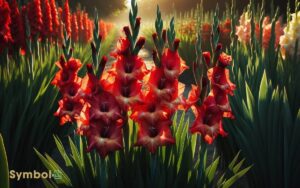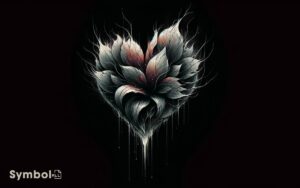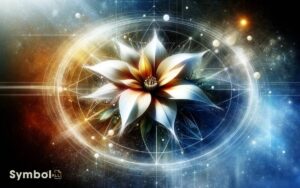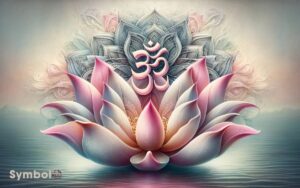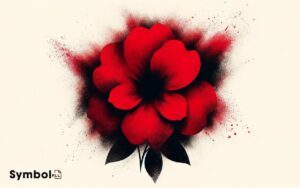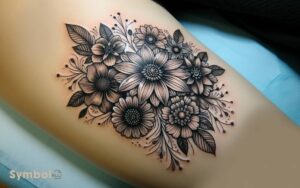Flower That Symbolizes Eternal Love: The Rose!
The rose, with its deep historical roots dating back about 70 million years in Asia, stands as the quintessential symbol of eternal love. Its cultivation began roughly 5,000 years ago, allowing for significant diversity in color and form through selective breeding.
With over 300 species in the genus Rosa, roses embody the complexity and profundity of love. In mythology, roses are tied to deities like Aphrodite and Venus, representing eternal love and the duality of beauty and pain.
Each color conveys a unique message, with red roses symbolizing deep love and passion. Revealing the layers of this symbol uncovers the enduring nature of human affection.
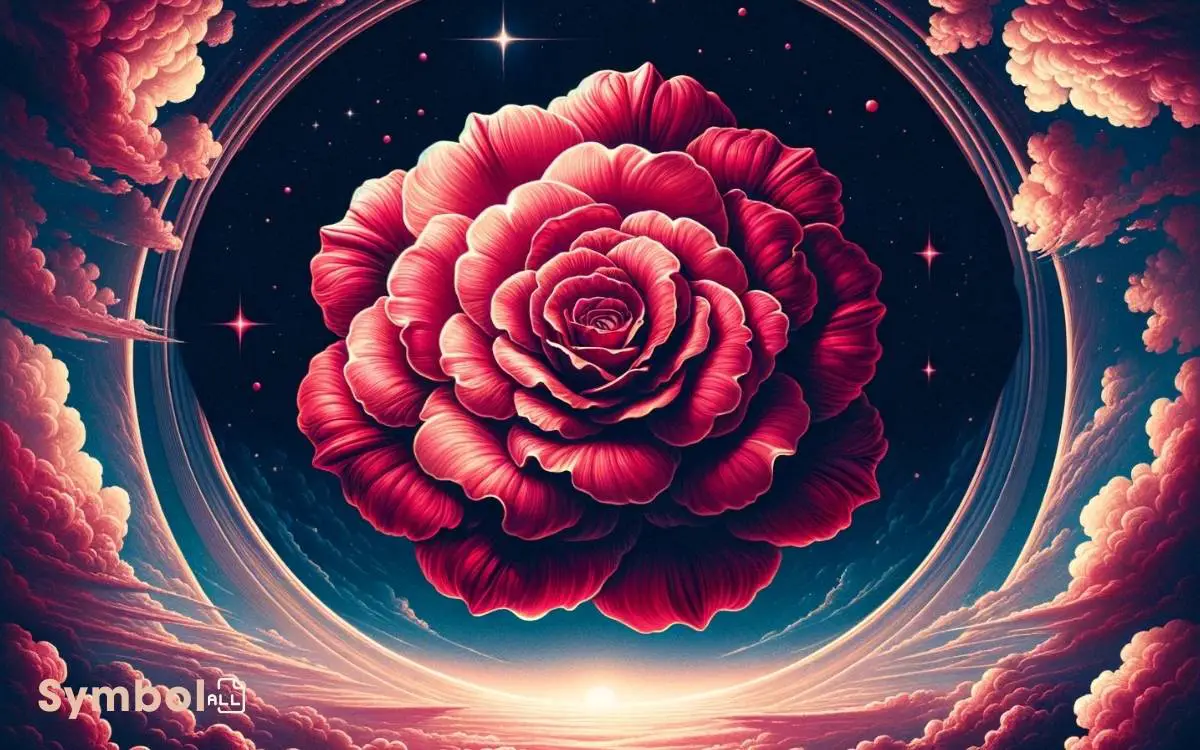
Key Takeaways
The Roses Ancient Origins
Roses, with their profound historical roots, have been symbols of love and beauty since ancient times, mesmerizing human interest and admiration.
Originating from Asia around 70 million years ago, according to fossil evidence, these plants have evolved through centuries. Their cultivation began approximately 5,000 years ago, possibly in China, marking their significant cultural integration.
You’ll find that roses weren’t merely ornamental but had practical uses in medicine, perfumery, and even culinary fields. The complexity of their breeding, resulting in diverse colors and forms, reflects human mastery over natural selection.
Scientifically, the genus Rosa comprises over three hundred species, showcasing an extraordinary adaptability to different climates and soils.
This adaptability, coupled with their inherent beauty, cements the rose’s status as a universal symbol of enduring love.
Mythological Tales of Love
Beyond their botanical significance, roses also play a pivotal role in various mythological tales of love, embodying deep symbolic meanings across different cultures.
In Greek mythology, roses are often linked to Aphrodite, the goddess of love, who’s said to have created the rose from her tears and the blood of her lover, Adonis, making the rose a symbol of eternal love and rebirth.
Similarly, in Roman mythology, Venus, the counterpart of Aphrodite, is associated with roses, which are considered sacred to her.
These tales not only highlight the rose’s significance in expressing love but also illustrate its role in symbolizing the duality of beauty and pain, representing the sacrifices often made in the name of love.
Symbolism Across Cultures
You’ll find that ancient Greek myths provide a foundational understanding of floral symbolism in the context of eternal love, highlighting a deep-rooted cultural significance.
When you compare these stories to Eastern traditions, it becomes evident how diverse societies interpret the symbolism of flowers in distinct yet overlapping ways.
Modern Western interpretations, in turn, have evolved from these historical perspectives, offering a unique blend of influences that reflect contemporary values and beliefs.
Ancient Greek Myths
In analyzing ancient Greek myths, one finds that flowers often carry profound symbolic meanings, reflecting themes of eternal love across diverse cultures.
Ancient Greeks meticulously integrated flora into their legends, attributing unique significances that resonate with themes of devotion and immortal affection.
- Anemone: Stemming from the tragic love tale of Adonis and Aphrodite, symbolizing fleeting love and hope.
- Rose: Associated with Aphrodite, embodying perfect beauty and everlasting love.
- Myrtle: Sacred to Aphrodite, representing marital fidelity and eternal love.
- Hyacinth: Arising from the sorrow of Apollo for Hyacinthus, symbolizing deep sorrow and longing.
- Ivy: Dedicated to Dionysus, signifies eternal loyalty and affection.
These myths illustrate how ancient Greeks envisioned flowers not merely as ornamental but as potent symbols of eternal love, embedding them deeply into their cultural tapestry.
Eastern Traditions Comparison
Similarly, Eastern traditions frequently weave complex symbolism into the fabric of their floral representations, often highlighting themes of eternal love with equal depth and nuance.
In Japan, for instance, the cherry blossom, or sakura, epitomizes the transient nature of life, which in turn accentuates the enduring aspect of love beyond the spiritual domain.
This concept, deeply rooted in Buddhist thought, suggests that true love transcends temporal boundaries.
Meanwhile, in Chinese culture, the peony stands as a symbol of romance, prosperity, and marital bliss, embodying the ideal of a harmonious and everlasting union.
These examples illustrate how Eastern societies utilize floral symbols to convey intricate narratives of love that endure beyond the constraints of time, reflecting a shared human fascination with the eternal.
Modern Western Interpretations
Exploring modern Western interpretations reveals a fascinating evolution in the symbolism of flowers, mirroring shifts in societal values and personal expressions of love.
You’ll uncover that:
- Roses, especially red ones, remain paramount symbols of enduring love, their biological longevity paralleling the concept of timeless affection.
- Tulips, with their varied hues, represent different facets of love, including declarations of passion and comfort in companionship.
- Orchids, exuding exotic beauty and sophistication, symbolize a deep, mature love that transcends the superficial.
- Peonies, embodying prosperity and romance, suggest a wish for a lasting and prosperous relationship.
- Sunflowers, turning towards the sun, illustrate loyalty and adoration, expressing faith in love’s power to grow and sustain itself.
This analysis encapsulates how cultural shifts influence the perception and expression of love through floral symbolism.
Varieties and Their Meanings
You’ll find that various flowers carry distinct meanings of eternal love, each rooted in deep historical and cultural significance.
The rose, for instance, symbolizes deep affection and devotion, with its origins tracing back to ancient civilizations where it was revered for its beauty and scent.
Similarly, the orchid, with its exotic appearance and resilience, represents a rare and enduring love. Its ability to thrive in diverse environments underscores its association with strong, persistent affection.
The lily, another flower linked to eternal love, symbolizes purity and renewal. Its presence in historical rituals and ceremonies highlights its enduring significance in representing lasting bonds. The lily’s pristine petals and delicate fragrance make it a poignant choice for both joyous occasions and moments of solemn reflection. Often placed at funerals, it serves as a flower symbolizing death of loved ones, offering comfort and hope to those in mourning. This dual role underscores the lily’s profound ability to embody both the sorrow of loss and the promise of new beginnings.
Each of these flowers, through their unique characteristics, contributes to a rich tapestry of symbols that articulate the complex nature of eternal love.
The Language of Colors
You’ll find that each color in a flower’s palette communicates a distinct message, rooted in a complex interplay of historical, cultural, and psychological factors.
For instance, red hues typically signify deep love and passion, a correlation that’s been reinforced through various scientific studies examining human emotional responses to color.
Analyzing these chromatic expressions allows for a nuanced understanding of how flowers can convey emotions like eternal love, transcending mere visual beauty to evoke profound feelings.
Color Meanings Unveiled
In the domain of floral symbolism, each color conveys a unique and scientifically grounded message, deeply influencing human emotions and interactions. Colors aren’t just visual elements but carry profound meanings, affecting our perception and behavior towards others.
- Red: Often associated with passion and desire, red flowers can elevate heart rate and convey deep emotions.
- Yellow: Symbolizing friendship and joy, yellow can stimulate mental activity and promote communication.
- Blue: Evoking calmness and serenity, blue flowers can reduce stress and create a sense of peace.
- White: Representing purity and innocence, white can evoke a sense of simplicity and cleanliness.
- Purple: Associated with royalty and dignity, purple flowers can stimulate imagination and creativity.
Understanding these color meanings helps you choose flowers that accurately express your deepest feelings and intentions.
Romance Through Hues
Understanding the scientific significance of color meanings in floral symbolism offers a foundation for exploring how specific hues can amplify the expression of romance and affection.
Red, universally recognized for its association with love, ignites feelings of passion and desire due to its vibrancy and intensity. This color’s wavelength stimulates a faster heartbeat, mirroring the physical effects of romantic attraction.
Pink, a softer variant, embodies gentleness, conveying a more tender, nurturing love. It’s the subtlety in pink that elicits feelings of comfort and warmth, essential components of a lasting bond.
White, symbolizing purity and new beginnings, reinforces the sincerity and depth of one’s feelings. Together, these colors weave a complex narrative of love’s multifaceted nature, allowing individuals to express nuanced emotions through the floral gifts they choose.
Celebrations and Ceremonies
Throughout various cultures, the flower symbolizing eternal love plays a pivotal role in celebrations and ceremonies, reflecting deeply ingrained societal values and beliefs.
You’ll find these blooms aren’t merely decorative but are imbued with meaning and purpose, contributing to the social cohesion and cultural identity of communities.
- Weddings: Symbolizing the eternal bond between partners.
- Anniversaries: Representing the enduring love and commitment over the years.
- Engagement ceremonies: Acting as a promise of everlasting love.
- Valentine’s Day: Exchanged as tokens of unending affection.
- Memorial services: Honoring the perpetual love for those who’ve passed.
These practices underscore the multifaceted symbolism of the flower, highlighting its capacity to convey complex emotional and cultural narratives in a universally understandable language.
Literary and Artistic Inspirations
Moving beyond their ceremonial uses, flowers symbolizing eternal love also profoundly influence literary and artistic expressions, offering rich, nuanced interpretations across various mediums.
You’ll find these symbols woven into the fabric of classic poetry, where they serve as metaphors for unyielding devotion.
In paintings, these flowers often anchor compositions, imbuing them with layers of meaning that speak to the enduring qualities of love.
This integration isn’t random; artists and writers meticulously choose flowers for their inherent symbolism, tapping into a shared cultural understanding to communicate complex emotions and themes.
Through detailed analysis, it’s evident that these floral symbols contribute significantly to the depth and resonance of artistic works, allowing audiences to explore the multifaceted nature of love and its perpetual influence on human expression.
Modern Day Significance
You observe that flowers continue to hold a pivotal role in romantic gestures today, with their usage and symbolism evolving alongside societal norms.
An analysis of cultural representations reveals a nuanced understanding of how these botanical symbols are embedded within modern rituals of love and commitment.
This exploration will uncover the ways in which these enduring symbols adapt to contemporary contexts, maintaining their relevance in expressing eternal love.
Romantic Gestures Today
In modern contexts, giving flowers as a romantic gesture intricately conveys emotions and intentions, symbolizing eternal love through a nuanced understanding of botanical meanings.
This practice, deeply rooted in tradition, has evolved, embracing a scientific approach to selecting the perfect floral message.
Consider these aspects when choosing flowers:
- Floral Genus and Species: Specific flowers carry unique symbolic meanings.
- Color Variations: Colors can alter a flower’s message, enhancing its emotional resonance.
- Bloom Seasonality: Seasonal flowers can signify the timing and durability of love.
- Arrangement Style: The composition of a bouquet can reflect personal sentiments and artistic expression.
- Cultivation Practices: Ethically sourced and environmentally conscious options can represent a commitment to sustainability, paralleling lasting love.
These factors contribute to a sophisticated, thoughtful expression of affection, demonstrating how modern romantic gestures continue to value depth, sustainability, and individuality.
Cultural Representations Explored
Exploring the cultural representations of flowers reveals their profound significance in modern expressions of love. Each blossom’s genus, color, and cultivation practices are meticulously analyzed to convey deep, personalized sentiments.
In this scenario, flowers aren’t merely decorative elements but rather symbols laden with complex meanings that vary across cultures.
For instance, the red rose universally signifies passionate love. Yet in some Eastern cultures, chrysanthemums represent loyalty and devoted love, reflecting cultural nuances.
Scientifically, the selection of a flower to symbolize eternal love involves understanding its biological longevity, resilience, and bloom cycle. These traits align with the notion of everlasting affection.
This analytical approach guarantees that the chosen flower accurately communicates the intended message of enduring love, making the gesture deeply significant.
Gardening and Care Tips
Maintaining the vibrancy and health of a flower symbolizing eternal love requires precise watering, soil conditions, and sunlight exposure.
To guarantee ideal growth and longevity, consider the following scientifically-backed gardening tips:
- Watering: Provide consistent moisture but avoid waterlogging the soil, as this can lead to root rot.
- Soil: Utilize a well-draining, fertile soil rich in organic matter to facilitate robust root development.
- Sunlight: Make sure your plant receives ample but not excessive sunlight; partial shade is often ideal.
- Fertilization: Apply a balanced, slow-release fertilizer to nourish your plant without overwhelming it.
- Pest Management: Regularly inspect for pests and diseases, using eco-friendly treatments to mitigate any issues promptly.
Adhering to these guidelines will help you nurture a symbol of eternal love that thrives in your garden.
Gifting Etiquette
When selecting a flower symbolizing eternal love as a gift, it’s important to understand the nuanced etiquette surrounding its presentation to ensure the gesture conveys the intended depth of feeling.
The selection process should take into account the recipient’s cultural background, as interpretations of flower meanings vary greatly across cultures.
For example, while red roses universally symbolize love, in some cultures, certain flowers may carry negative connotations.
It’s also essential to pay attention to the number of flowers presented. In many Eastern cultures, even numbers are associated with funerals, while odd numbers are considered more auspicious for celebrations of love.
Packaging shouldn’t be underestimated; a carefully chosen wrapper can enhance the symbolic value of the gift, signaling thoughtfulness and the seriousness of one’s intentions.
Environmental Impact
The cultivation and distribution of flowers for romantic gestures, including those symbolizing eternal love, have significant environmental implications that you should take into account.
- Water usage: The extensive irrigation needed for flower farming can deplete local water resources, affecting both ecosystems and human communities.
- Pesticide and fertilizer use: To maintain the aesthetic qualities of these flowers, high levels of chemicals are often used, leading to soil and water pollution.
- Carbon footprint: The transportation of flowers across the globe generates a substantial amount of CO2 emissions, contributing to climate change.
- Land use: Large-scale flower cultivation can lead to deforestation and loss of habitats for native species.
- Waste: The short lifespan of cut flowers leads to considerable organic waste, which, if not properly managed, can contribute to methane emissions.
Understanding these impacts is essential for making informed decisions about expressing love in environmentally sustainable ways.
Future of Romantic Gestures
Recognizing the environmental impacts of traditional romantic gestures, it’s essential to explore innovative and sustainable alternatives for expressing love in the future.
As you immerse yourself in this investigation, consider the importance of adopting practices that not only convey affection but also respect for our planet.
| Sustainable Gesture | Environmental Benefit | Potential for Personalization |
|---|---|---|
| Digital love letters | Reduces paper waste | High, with multimedia elements |
| Planting a tree together | Enhances biodiversity | Moderate, with species choice |
| Eco-friendly jewelry | Lowers resource extraction | High, with material selection |
| Solar-powered decorative lights | Reduces energy consumption | Moderate, with design options |
| Upcycled art projects | Minimizes landfill contributions | High, through creative expression |
Embracing these alternatives sets the stage for a future where romantic gestures contribute positively to both personal relationships and the environment.
Conclusion
In wrapping up, it’s clear that roses aren’t just a drop in the ocean when it comes to symbolizing eternal love. Their deep-rooted history, rich in mythology and cultural significance, alongside the diverse meanings attributed to their varieties and colors, underscores their timeless appeal.
Whether you’re tending to their delicate needs in a garden, selecting the perfect bloom for a loved one, or pondering their environmental impact, roses speak a universal language of affection. As romantic gestures evolve, the rose steadfastly remains a symbol of undying love.

